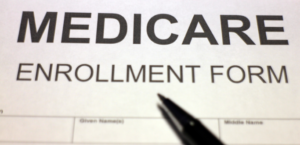Medicare is the federal health insurance plan. Social Security determines eligibility, but the plan is available to people with chronic illnesses and adults age 65 and older. For most Americans, the process of signing up is simple.
Suppose you or your spouse has paid Social Security taxes through your  employment for ten years or more. In that case, Social Security will send you your Medicare Card in the mail three months before you turn 65. It comes with instructions on how to enroll.
employment for ten years or more. In that case, Social Security will send you your Medicare Card in the mail three months before you turn 65. It comes with instructions on how to enroll.
Conveniently, this also marks your Initial Enrollment Period, three months before the month of your 65th birthday. This enrollment period extends three months after your birth month for a total of seven months.
The Medicare.gov and ssa.gov websites can direct you to forms for enrollment. After providing personal information, you can easily open your account. Enroll during your initial enrollment or general enrollment from January through March of each year.
Medicare Options
Your Medicare options begin with Original Medicare: Part A and Part B. These cover hospital insurance and medical insurance. Most people will qualify for premium-free Part A. You can choose not to enroll in Part B if you have other medical coverage.
If you are interested in additional coverage, you can consider Medicare Advantage plans (Part C) or Medicare prescription drug coverage (Part D). To help cover your Part A and Part B expenses, you can sign up for a Medicare Supplement plan. It is important to note that you cannot have both a Part C plan and a Medicare Supplement plan.
You can sign up for these other plans during the General Enrollment Period from January to March or later in the year from October through December when you can switch plans.
Medicare Advantage (Part C) plans are offered through private Medicare-approved companies and cover hospital and medical insurance exactly like Part A and Part B. Additionally, most plans also have prescription drug coverage and may offer vision, dental, or hearing coverage.
Medicare Supplement insurance, sometimes called Medigap policies, can help you afford your Medicare coverage. They pay everything except the Part B deductible, including the Part A deductible, coinsurance, and copayments.
Medicare standardizes prescription drug coverage (Part D) plans. Each plan covers at least two drugs in each category. You pay a copayment based on the plan’s formulary, its list of tiered drug groups. If you get a generic preferred prescription drug, your copayment is lower than a specialized drug or non-preferred brand-name drug.
You can add or drop a Part D plan at any time but may have to pay a late enrollment fee if you pick up the plan after not having creditable drug coverage for several months.
Finding the Best Coverage
There are many Medicare Advantage and Supplement plan options out there, so do some research to find the best coverage at the right price for you.
For all of your Medicare questions, seek out Medicare on Video. We’re here to bring you the answers quickly and easily.
















